CHEVROLET TAHOE 1996 1.G Workshop Manual
Manufacturer: CHEVROLET, Model Year: 1996, Model line: TAHOE, Model: CHEVROLET TAHOE 1996 1.GPages: 403, PDF Size: 20.63 MB
Page 51 of 403
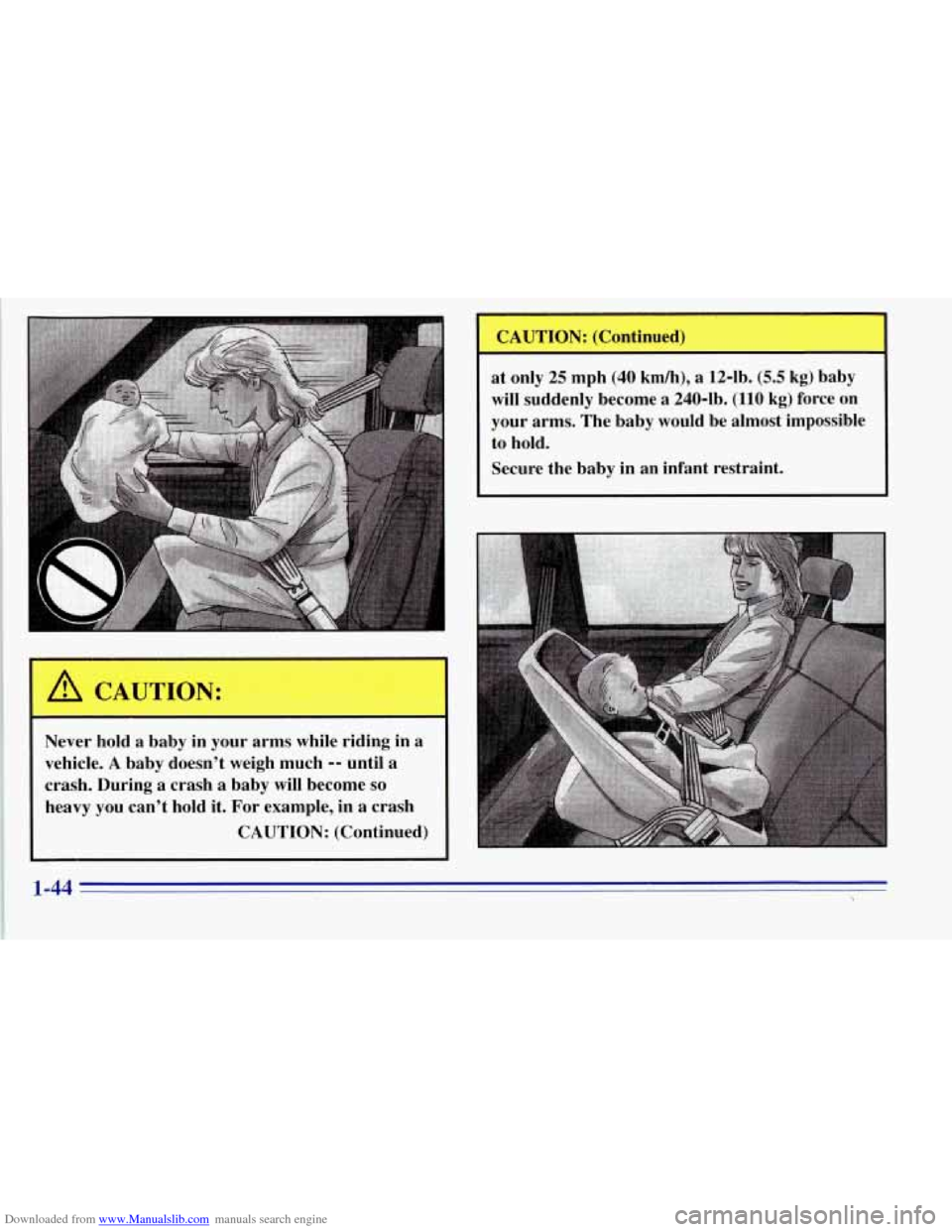
Downloaded from www.Manualslib.com manuals search engine CAUTION: (Continued)
at only 25 mph
(40 km/h), a 12-lb. (5.5 kg) baby
will suddenly become a 240-lb. (110 kg) force on
your arms. The
baby would be almost impossible
to hold.
Secure the baby in
an infant restraint.
I
Never hold a baby in your arms while riding in a
vehicle. A baby doesn’t weigh much -- until a
crash. During a crash a baby will become so
heavy you can’t hold it. For example, in a crash
CAUTION: (Continued)
1-44
Page 52 of 403
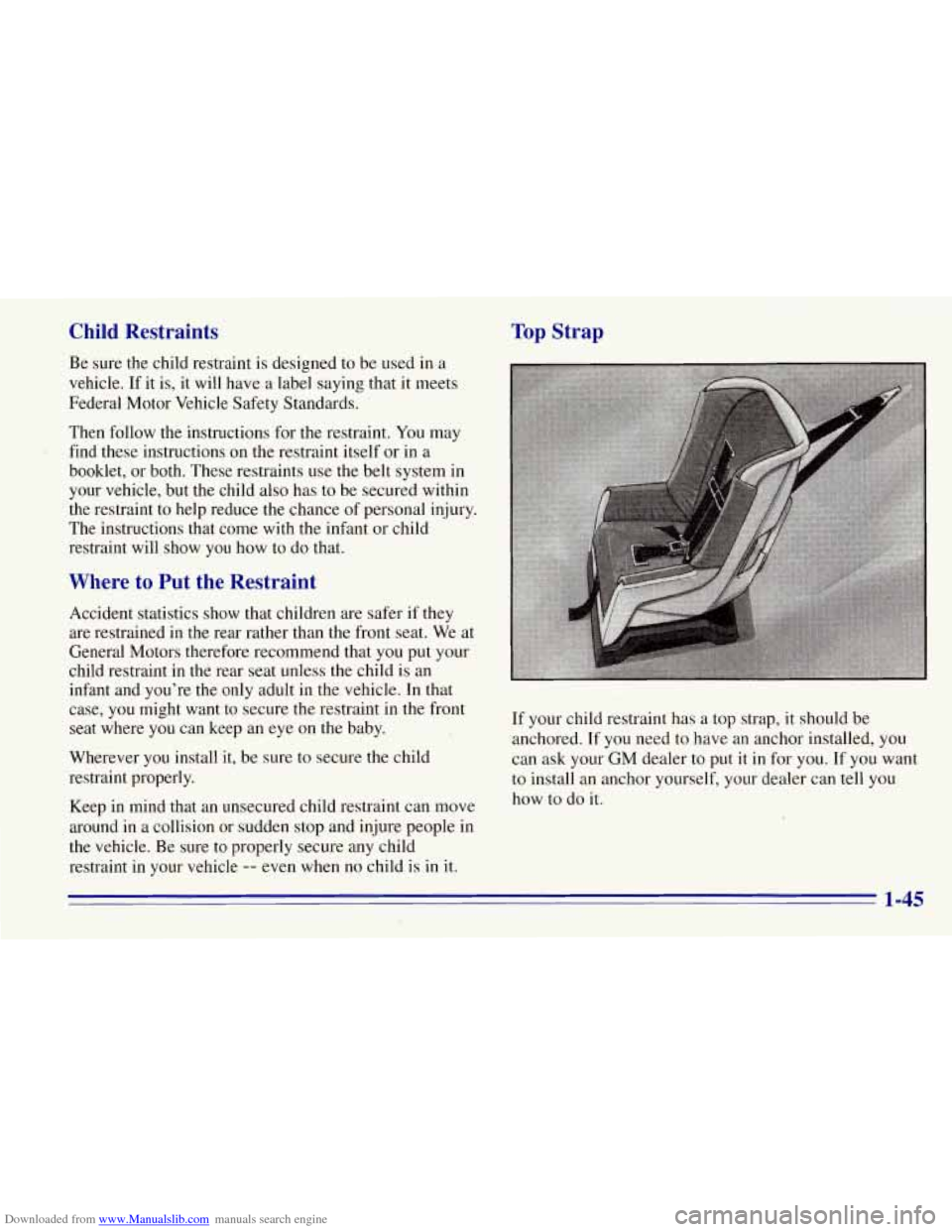
Downloaded from www.Manualslib.com manuals search engine Child Restraints
Be sure the child 'restraint is designed to be used in a
vehicle.
If it is, it will have a label saying that it meets
Federal Motor Vehicle Safety Standards.
Then follow the instructions for the restraint.
You may
find these instructions on the restraint itself or in a
booklet, or both. These restraints use the belt system in
your vehicle, but the child also has to be secured within
the restraint to help reduce the chance of personal injury.
The instructions that come with the infant or child
restraint will show you how to do that.
Where to Put the Restraint
Accident statistics show that children are safer if they
are restrained in the rear rather than the front seat. We at
General Motors therefore recommend that you put your
child restraint in the rear seat unless the child
is an
infant and you're the .only adult in the vehic1.e. In that
case, you might want to secure the restraint in the front
seat where you can keep an eye on the baby.
Wherever you install it, be sure to secure the child
restraint properly.
Keep in mind that an unsecured child restraint can move
around in a collision or sudden stop and injure people
in
the vehicle. Be sure to properly secure any child
restraint in your vehicle
-- even when no child is in it.
Top Strap
If your child restraint has a top strap, it should be
anchored. If you need to have an anchor instalIed, you
can ask your
GM dealer to put it in for you. If you want
to install an anchor yourself, your dealer can tell you
how to do it.
1-45
Page 53 of 403
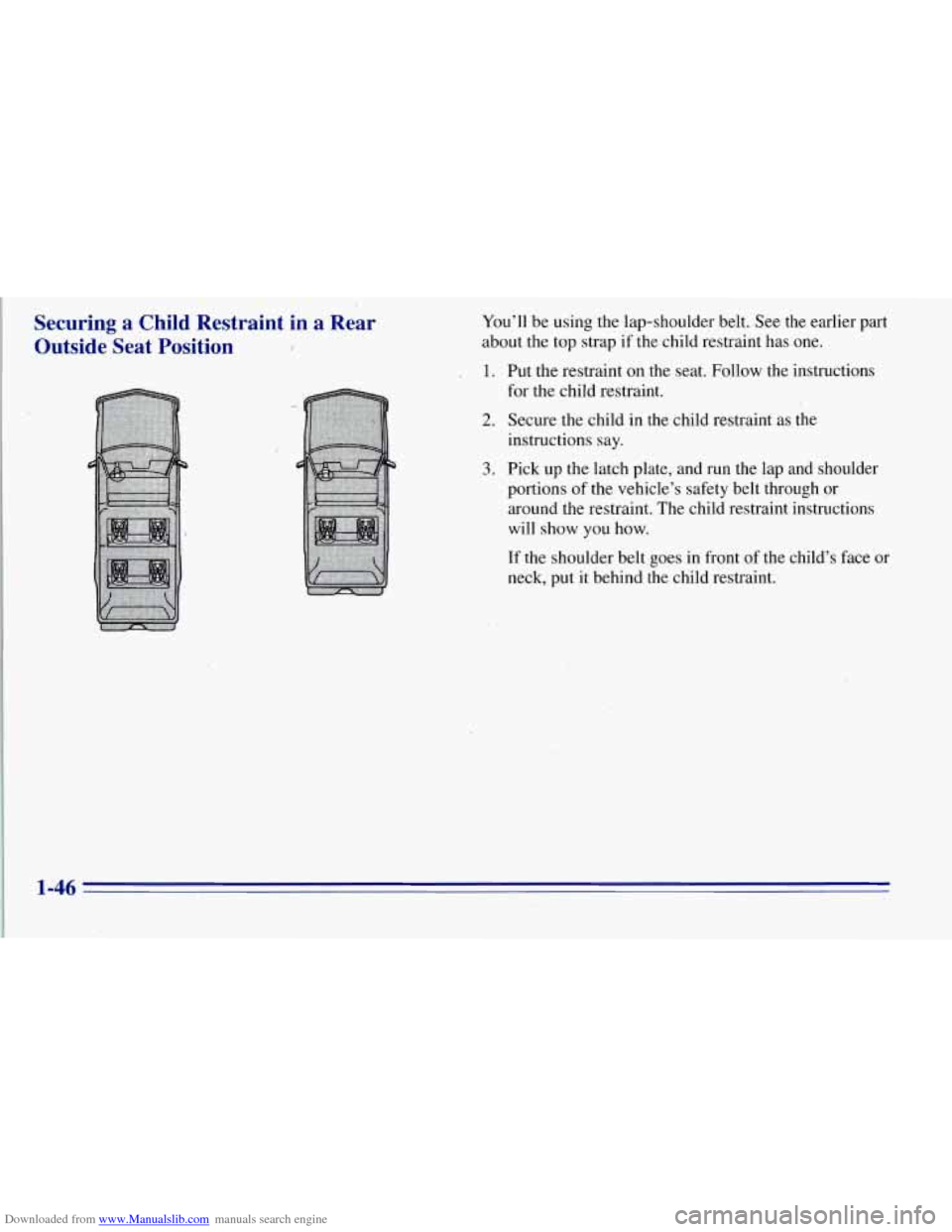
Downloaded from www.Manualslib.com manuals search engine Securing a Child Restraint in a Rear
Outside Seat Position
I
You’ll be using the lap-shoulder belt. See the earlier part
about the top strap if the child restraint has one.
1.
2.
3.
Put the restraint on the seat. Follow the instructions
for the child restraint.
Secure the child in the child restraint as the
instructions
say.
Pick up the latch plate, and run the lap and shoulder
portions of the vehicle’s safety belt through pr
around the restraint. The child restraint instructions
will show
you how.
If the shoulder belt goes in front of the child’s face or
neck, put it behind the child restraint.
Page 54 of 403
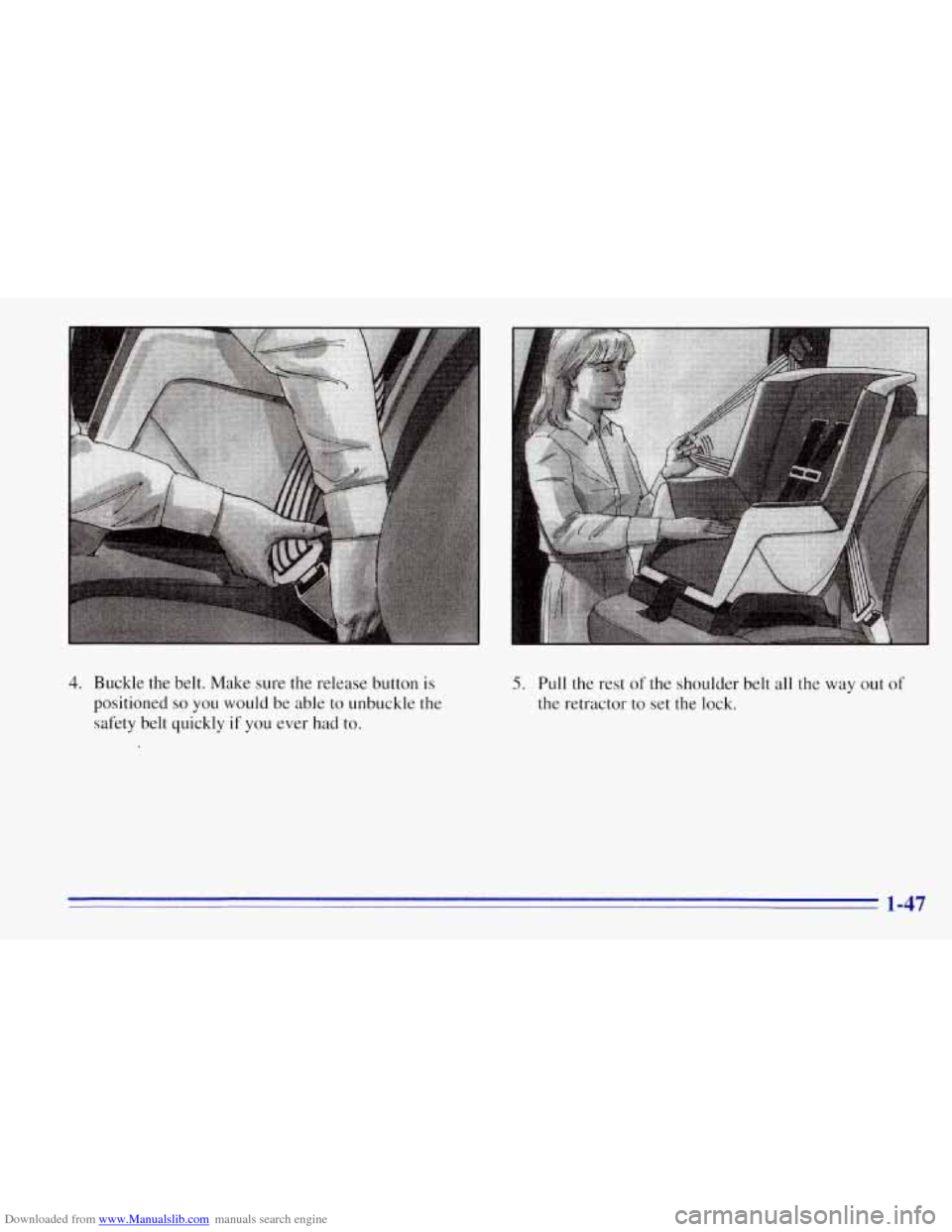
Downloaded from www.Manualslib.com manuals search engine 4. Buckle the belt. Make sure the release button is
positioned so you would be able to unbuckle the
safety belt quickly
if you ever had to.
5. Pull the rest of the shoulder belt all the way out of
the retractor to set the lock.
1-47
Page 55 of 403
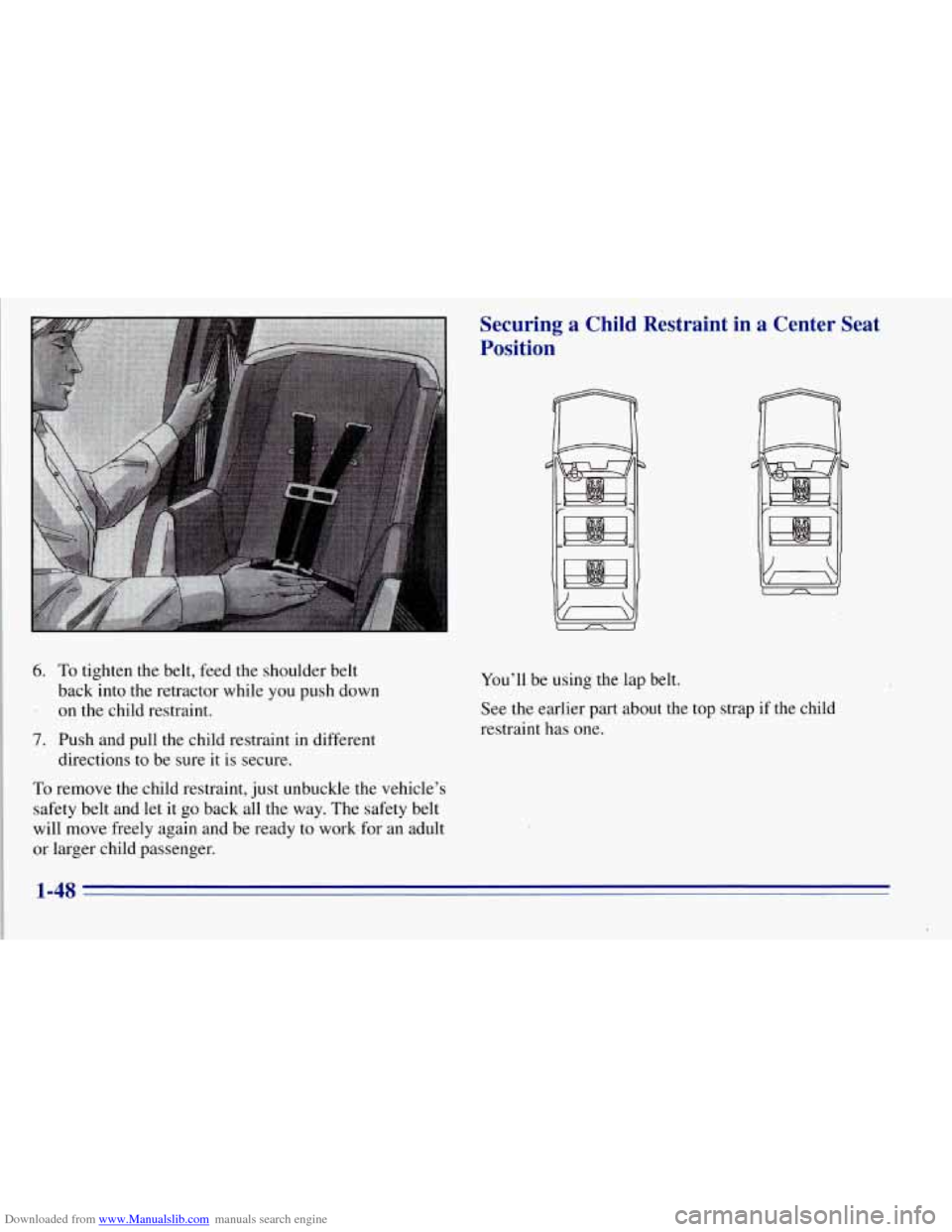
Downloaded from www.Manualslib.com manuals search engine 6. To tighten the belt, feed the shoulder belt
. on the child restraint.
back into the retractor while
you push down
7. Push and pull the child restraint in different
directions to be sure it is secure.
To remove the child restraint, just unbuckle the vehicle’s
safety belt and let it
go back all the way. The safety belt
will move.freely again and be ready to work for an adult
or larger bhild passenger.
Securing a Child Restraint in a Center Seat
Position
You’ll be using the lap belt.
See the earlier part about the top strap if the child
restraint
has one.
1-48
Page 56 of 403
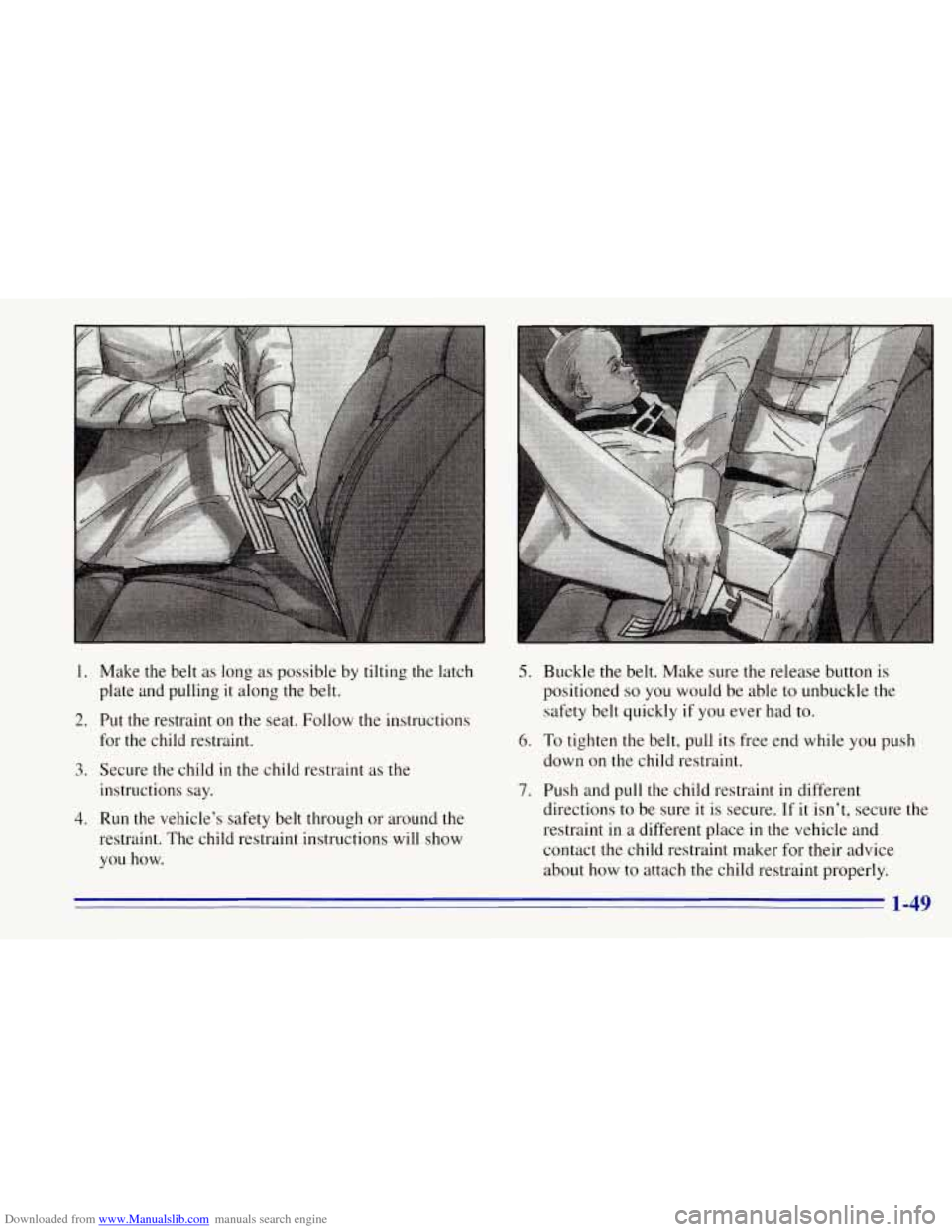
Downloaded from www.Manualslib.com manuals search engine 1. Make the belt as long as possible by tilting the latch
plate and pulling
it along the belt.
2. Put the restraint on the seat. Follow the instructions
for the child restraint.
3. Secure the child in the child restraint as the
instructions say.
4. Run the vehicle's safety belt through or around the
restraint. The child restraint instructions will show
you how.
5. Buckle the belt. Make sure the release button is
positioned
so you would be able to unbuckle the
safety belt quickly
if you ever had to.
6. To tighten the belt, pull its free end while you push
down on the child restraint.
7. Push and pull the child restraint in different
directions to be sure it
is secure. If it isn't, secure the
restraint in
a different place in the vehicle and
contact the child restraint maker for their advice
about how to attach the child restraint properly.
1-49
Page 57 of 403
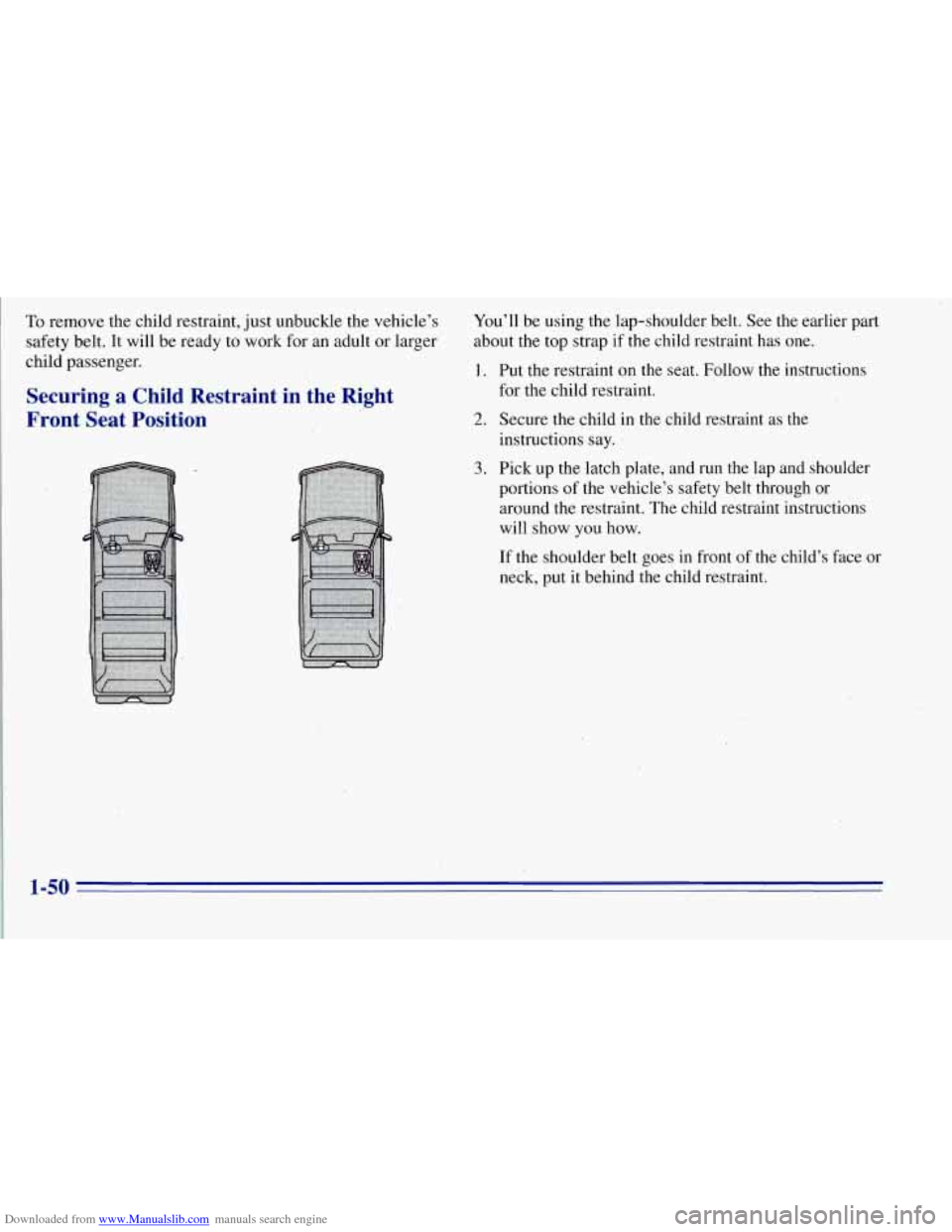
Downloaded from www.Manualslib.com manuals search engine To remove the child restraint, just unbuckle the vehicle’s
safety belt, It will be ready to work for an adult or larger
child passenger.
Securing a Child Restraint in the Right
Front Seat Position
You’ll be using the lap-shoulder belt. See the earlier part
about the top strap if the child restraint has one.
1. Put the restraint on the seat. Follow the instructions
for the child restraint.
2. Secure the child in the child restraint as the
instructions say.
3. Pick up the latch plate, and run the lap and shoulder
portions of the vehicle’s safety belt through or
around the restraint. The child restraint instructions
will show
you how.
If the shoulder belt goes in front of the child’s face or
neck, put it behind the child restraint.
1-50
Page 58 of 403
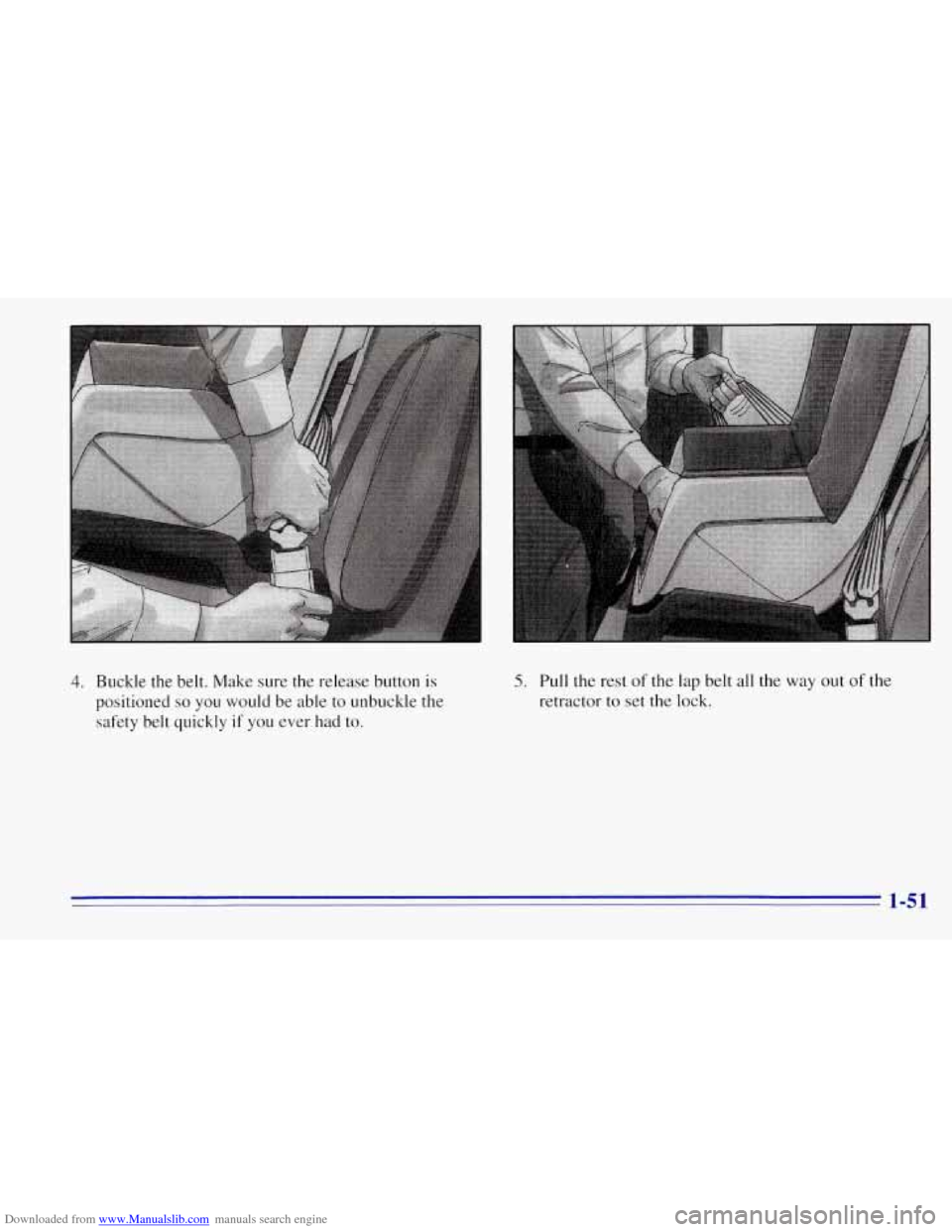
Downloaded from www.Manualslib.com manuals search engine I
4. Buckle the belt. Make sure the release button is
positioned
so you would be able to unbuckle the
safety belt quickly if you ever had to.
5. Pull the rest of the lap belt all the way out of the
retractor
to set the lock.
1-51
Page 59 of 403
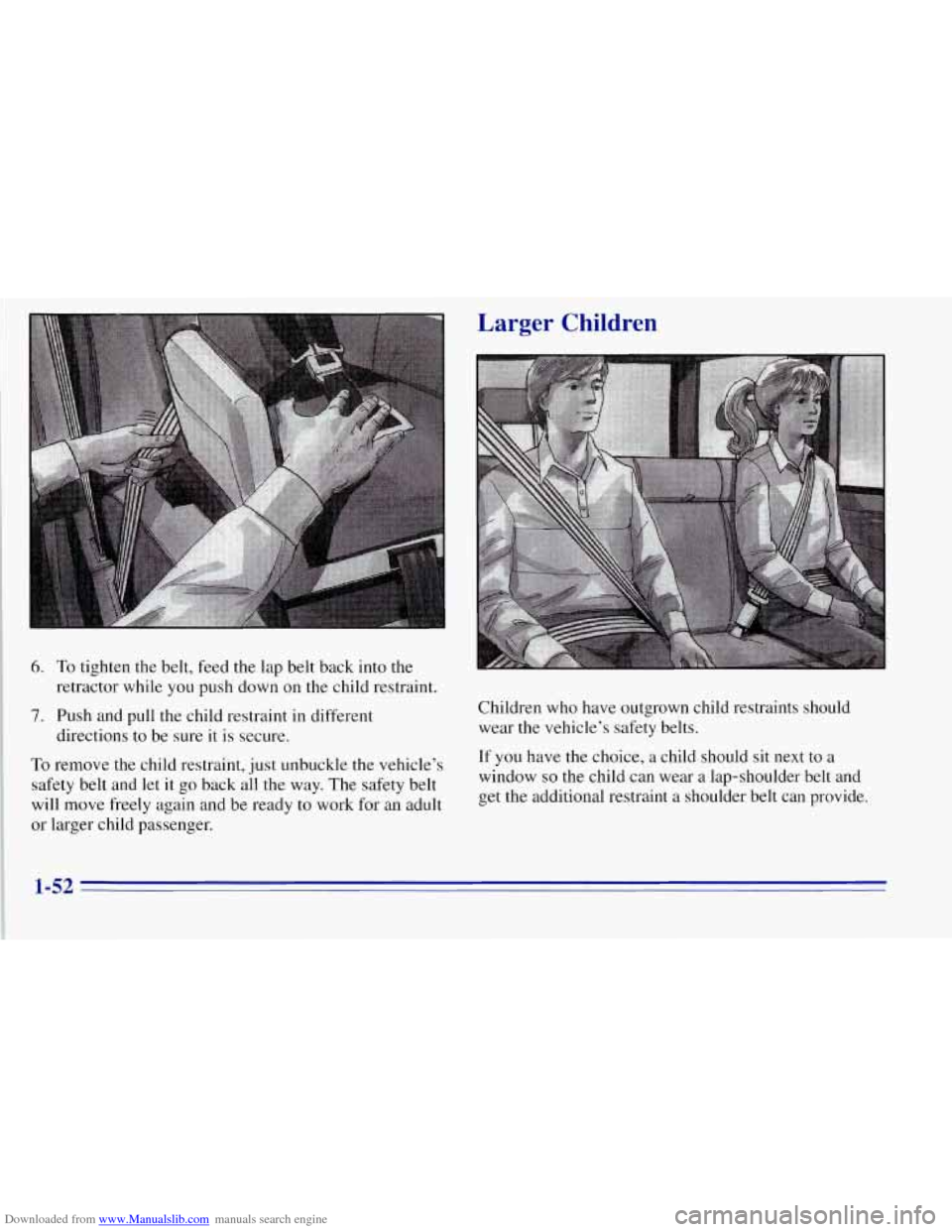
Downloaded from www.Manualslib.com manuals search engine 6. To tighten the belt, feed the lap belt back into the
retractor while you push down on the child restraint.
~ 7. Push and pull the child restraint in different
directions
to be sure it is secure.
To remove the child restraint, just unbuckle the vehicle’s
safety belt and
let it go back all the way. The safety belt
~ will move freely again and be ready to work for an adult
~ or larger child passenger.
Larger Children
Children who have outgrown child restraints should
wear the vehicle’s safety belts.
If you have the choice, a child should sit next to a
window
so the child can wear a lap-shoulder belt and
get the additional restraint
a shoulder belt can provide.
1-52
Page 60 of 403
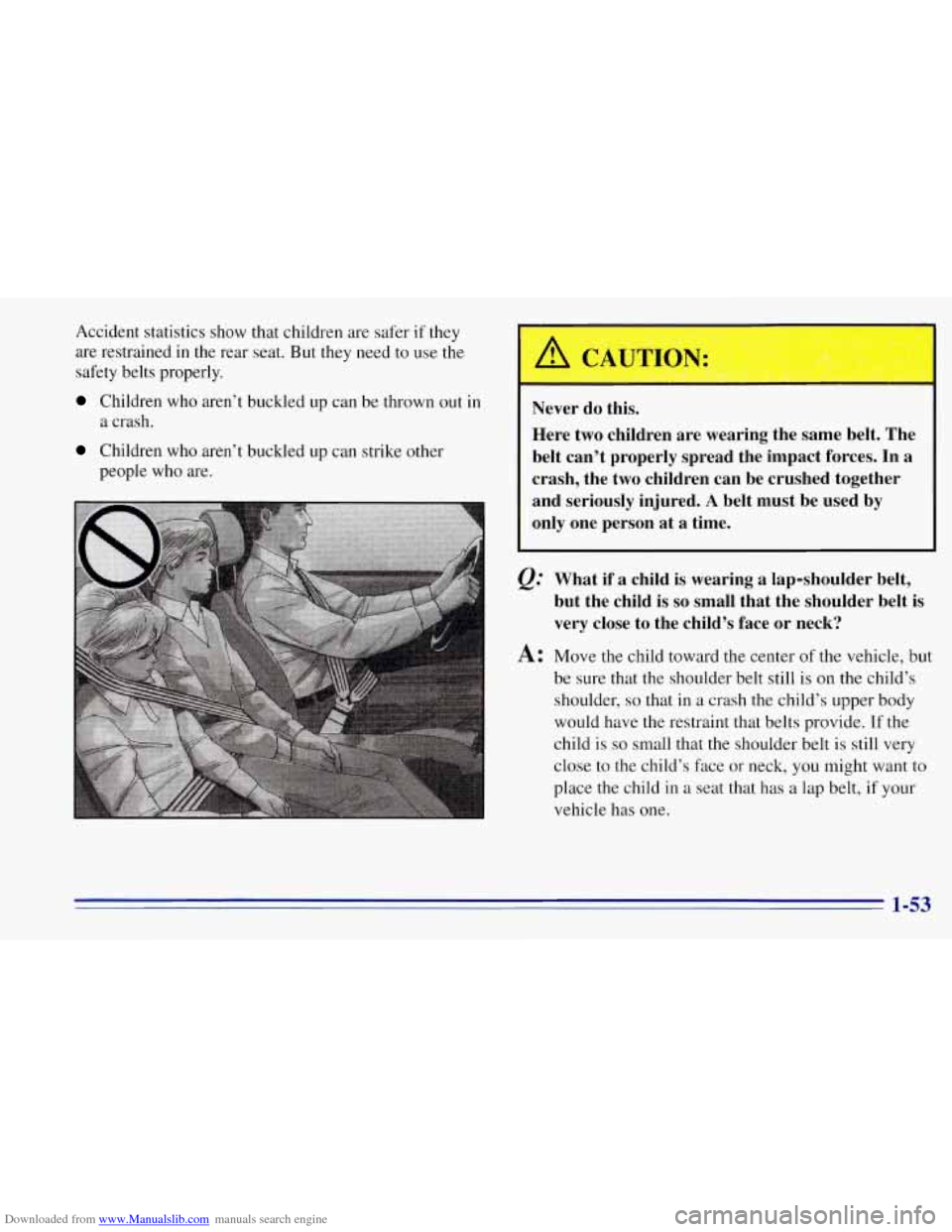
Downloaded from www.Manualslib.com manuals search engine Accident statistics show that children are safer if they
are restrained in the rear seat. But they need to use the
safety belts properly.
Children who aren’t buckled up can be thrown out in
a crash.
Children who aren’t buckled up can strike other
people who are.
Never do this.
Here two children are wearing the same belt. The
belt can’t properly spread the impact forces. In a
crash, the two children can be crushed together
and seriously injured.
A belt must be used by
only one person at a time.
What if a child is wearing a lap-shoulder belt,
but the child is
so small that the shoulder belt is
very close to the child’s face or neck?
A: Move the child toward the center of the vehicle, but
be sure that the shoulder belt still is on the child’s
shoulder,
so that in a crash the child’s upper body
would have the restraint that belts provide.
If the
child is
so small that the shoulder belt is still very
close to the child’s face or neck, you might want
to
place the child in a seat that has a lap belt, if your
vehicle has one.
1-53